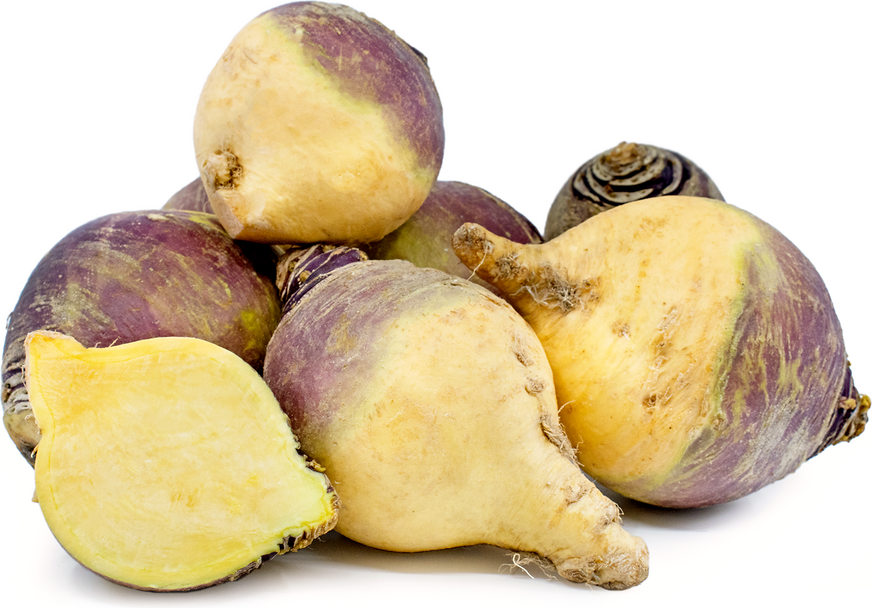


Rutabagas
Estimated Inventory, 25 lbs : 5.04
This item was last sold on : 07/28/25
Description/Taste
Rutabagas are the roots of a hardy biennial plant, with bluish-colored leaves similar to those of a cabbage, yet smoother. Young leaves can be eaten, though some must remain on the plant to keep the root alive. Rutabagas are larger than a turnip, described by horticulturalists as having a “swollen neck” where the stems and leaves protrude. The color of the root is typically yellow at the tip with a dark purple stain at the neck and shoulders. Rutabagas have a milder taste than turnips, though they do have a similar bitterness. The younger, smaller Rutabagas harvested between two and 3 inches in diameter offer a mild cruciferous flavor. For a sweeter taste, it is recommended that the roots remain underground until around four to 5 inches in size. The roots can be stored in the ground for up to a year before they are harvested. Roots kept underground for a longer period of time can range in color from white to yellow to all purple. The flesh of a Rutabaga is yellow, its texture firm and fine-grained. When cooked, the flavor is sometimes described as sweet, yet savory; like a richly flavored golden potato.
Seasons/Availability
Rutabagas are available year-round with a peak season during the winter months.
Current Facts
The Rutabaga root, pronounced ROOT-a-BAY-ga, is a member of the cruciferous family of vegetables. Botanically known as Brassica napus var. napobrassica, the Rutabaga is a cross between a cabbage and a turnip. Rutabagas are a winter crop, and because of their nutrient-dense leaves they are sometimes planted by farmers as feed for livestock. The tuber, also called a Swedish turnip or “Swede,” does most of its growing under the cooler winter temperatures, so it can be harvested well into the spring months.
Nutritional Value
The Swedish-born root is high in iron, which is not typical of most vegetables. They have around 25% of the recommended daily amount of vitamin C and are a good source of vitamin A. Rutabagas are low in fat and cholesterol free, and they contain a moderate amount of dietary fiber.
Applications
Rutabagas are easier to prepare than many other root vegetables thanks in part to an easy-to-peel skin. Once the skin is removed, Rutabagas can be sliced, diced, or cut into wedges depending on the intended preparation. Often used in place of potatoes in Swedish and northern European dishes, the Rutabaga is boiled and then mashed or pureed, roasted and even eaten raw. Sautee onions, celery and carrots with diced Rutabaga for the base of a pureed Rutabaga soup. As an alternative to potatoes, cut a Rutabaga so it sits flat on a baking sheet and score the other side, a la “hasselback potatoes,” insert garlic and oil between the slices of root and bake. Rutabagas can be kept for months in cool, slightly humid conditions, and can be stored unwashed in the crisper of the refrigerator for up to two weeks. Prior to storing, cut greens at least an inch above the root if still attached.
Ethnic/Cultural Info
The International Rutabaga Curling Championship takes place annually on the last day of the market season at the Ithaca, New York Farmers' Market. This event has been held since 1998, with participants using only Rutabagas in their curling competition. The rules prohibit the use of any vegetable other than a Rutabaga, and recommend bringing your own.
Geography/History
Rutabagas were created by Swiss botanist Gaspard Bauhin during the seventeenth century, through a cross between a cabbage and a turnip. The word Rutabaga comes from the Swedish “rotabagge” or “baggy root.” Rutabagas didn’t appear in the United States until around the turn of the 19th century and were first cultivated in the northern part of the country. The cold-hardy vegetable is drought resistant and maintains its nutrients and minerals far into the winter months, regardless of frost. For this reason, and for its high percentage of protein and easy digestibility, Rutabaga has become a popular grazing crop for livestock in the United States. Multiple varieties of Rutabaga exist, among them the Purple Top Yellow, Macomber and American Purple Top Yellow. Rutabagas are grown most often in the cooler northern regions of the United States, Canada, Europe, and Great Britain. Its popularity in Sweden earned it the moniker “Swede,” which is still used throughout much of Europe today.
Featured Restaurants
Restaurants currently purchasing this product as an ingredient for their menu.
| The Shores | La Jolla CA | 858-459-8271 |
| Shakespeare's Corner Shoppe & Afternoon Tea | San Diego CA | 619-683-2748 |
| Ridgeview Health Center | San Diego CA | 858-293-3950 |
| Top of the Market | San Diego CA | 619-234-4867 |
| Trust Restaurant | San Diego CA | 609-780-7572 |
| Fort Oak | San Diego CA | 619-795-6901 |
Recipe Ideas
Recipes that include Rutabagas. One




